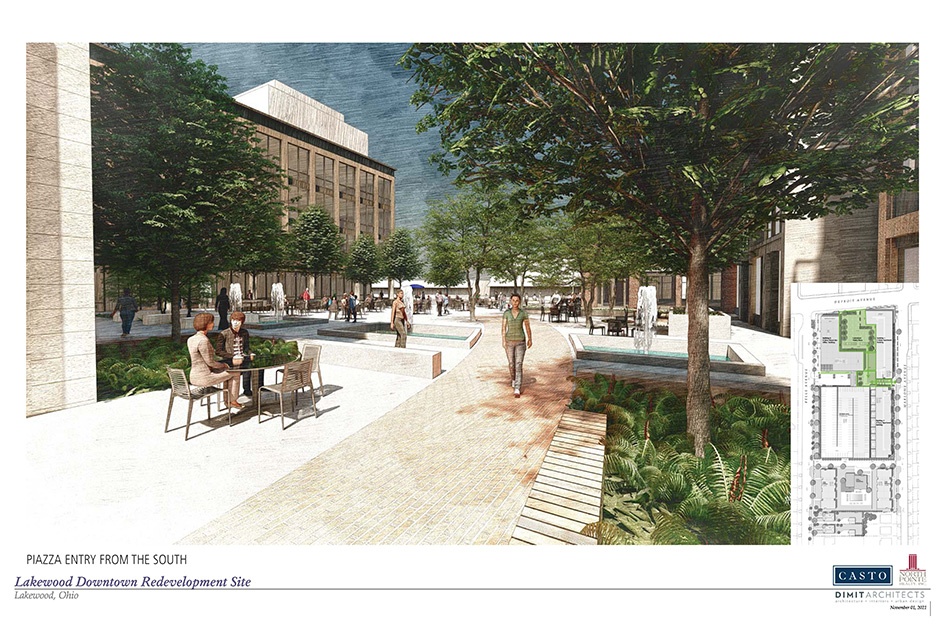
An enclosed Huntington Bank Field in suburban Brook Park could be supported by a new sports facility and education fund proposed by Ohio Gov. Mike DeWine. But the fund would be site-agnostic, giving life to those seeking to keep the Cleveland Browns playing their home games in Downtown Cleveland (HKS). CLICK IMAGES TO ENLARGE THEM.
Sports facility-education fund gets mixed reception
A COMMENTARY
Everything from helping to finance a new stadium for the Cleveland Browns to funding sports programs for low-income families could be supported by a new sports facility and education fund sought by Ohio Gov. Mike DeWine in his proposed state budget. But the proposed fund doesn’t pick a stadium site for the Browns, which appears to give Downtown Cleveland site backers more of a win than it does for the owners of the pro football team.
DeWine on Monday announced a new Sports Facilities Construction and Sports Education Fund could be funded by doubling the state’s sports betting tax rate to 40 percent. The permanent tax increase could generate $130 million to $180 million per year in new revenue, the DeWine Administration estimates.
“These sports gaming (companies) are extremely aggressive…. They’re in your face all the time,” DeWine told the Ohio Capital-Journal. “They’re getting Ohioans to lose massive amounts of money every year, and it seems to me only just and fair that some of the stadiums be paid for by them or a portion of it.”
The fund would be overseen by a new commission appointed by the governor and the state legislature. The proposal was submitted earlier this week by DeWine to the Ohio General Assembly as part of the state’s 2026-27 operating budget. The budget has to be approved by the legislature before the start of the state’s fiscal year on July 1.
After that, the agency under whose umbrella this program would be administered will issue draft rules for how the program will be managed and measured. Based on how new state programs in the recent past were implemented, that could take anywhere from six months to a year before it could start soliciting for funding applications.
That’s cutting it pretty close for the enclosed Huntington Bank Field in Brook Park, planned by Haslam Sports Group (HSG), owner of the Browns. A groundbreaking for that $2.4 billion facility on Snow Road at Interstate 71 is sought in 2026.
That would give HSG three years of construction time to build the new stadium before the Browns’ 2029 season starts in August of that year. Its current downtown stadium lease ends after the 2028 football season.
HSG has requested $600 million in state funds for the stadium from capturing state taxes generated generated by the new facility and its supportive developments like hotels, shops, restaurants, offices, hotels and entertainment. Those would service a bond issue for up to 30 years.
Those activities would also generate local taxes, parking and other revenues to be captured so they could service construction loans, too. That is HSG’s preferred approach, not DeWine’s stadium fund.
“We appreciate Governor DeWine’s commitment to looking at creative ways to solve sports facilities development while positively impacting youth sports throughout Ohio,” said Dave Jenkins, HSG’s chief operating officer. “We look forward to learning more about the options this legislation may provide.”
“At the same time, we continue to work with the appropriate stakeholders and other experienced experts to develop alternative funding mechanisms for an enclosed Huntington Bank Field in Brook Park, knowing the importance of not tapping into existing taxpayer funds that go to other pressing community needs,” Jenkins added. “The model we’ve proposed on the state level would leverage only the incremental tax revenues from within the development itself to enable the project.”
Jenkins says the Brook Park Huntington Bank Field and surrounding development project would be a “robust” economic engine from which the state could leverage state tax revenues to support construction bonds.
The fact that DeWine is pursuing the statewide fund suggests he either doesn’t trust the Haslams’ economic impact numbers, he doesn’t want to take sides in the Brook Park versus Downtown Cleveland stadium location legal battle, or both. The Haslams and Cleveland have filed suit against each other over where the Browns should play.
DeWine’s rejection of the Haslam’s site-specific funding proposal and preference for a site-agnostic state fund is a potential win for Cuyahoga County Executive Chris Ronayne and Cleveland Mayor Justin Bibb who are leading the charge to keep the Browns downtown. They either want the existing stadium at North Coast Harbor renovated for $1.2 billion or a new domed stadium at Burke Lakefront Airport costing $3.3 billion.
DeWine also is acknowledging that the Haslams aren’t the only ones fishing for funds. In Cincinnati, Michael Brown, owner of the National Football League Bengals, wants public dollars to help make $1.25 billion worth of renovations to Paycor Stadium on the Ohio River waterfront. And it’s also not just about American football.
Back here in Northeast Ohio, Cleveland Soccer Group led by CEO Michael Murphy is seeking about $90 million in public funds for a $150 million, 12,500-seat stadium just south of Downtown Cleveland’s existing Gateway sports and entertainment district.
Murphy has called it a “unique community asset” that will be unlike anything else in Northeast Ohio. And he notes that it would not just be a venue for professional athletes but for a variety of community activities.
“We’re excited about Governor DeWine’s budget proposal that would help fund youth sports and new facilities,” Murphy told NEOtrans. “This investment will enhance opportunities for local athletes and bring a world-class venue to Cleveland that will boost tourism, create jobs, and grow our economy. Together, we can transform South Gateway for generations to come.”
“At Cleveland Soccer Group, we believe in the power of sports to drive economic growth and unite communities,” Murphy continued. “A new, multi-purpose stadium in Downtown Cleveland would not only bring new professional men’s and women’s soccer teams to the city, but also host a variety of events year-round, from high school and collegiate athletics to professional sports like lacrosse and rugby, as well as concerts and festivals.”
There are also concerns that DeWine’s proposed fund assumes some optimistic revenue projections. But assuming the low-end estimate proves to be the actual revenue, $130 million could provide satisfy all of the major stadium projects and still leave tens of millions of dollars for other sports projects and programs.
Consider that a $600 million Browns stadium bond issue from the state could be serviced by $38.7 million per year over 30 years at 5 percent interest. Or a 15-year, $600 million bond issue at 5.5 percent interest might need $58.8 million per year to retire it. A large chunk of the fund could be locked in to the Browns stadium for a long time.
That’s assuming DeWine’s stadium and sports fund survives the General Assembly and lobbying from the likes of FanDuel, DraftKings, BetMGM, Fanatics Sportsbook and their industry association, the Sports Betting Alliance. They decried the fund being supported by “a 400 percent tax increase over a two-year period.”
Ohio taxes on sports betting went from 10 percent when it first became legal in January 2023 to 20 percent in July 2023. A 40 percent tax rate would be the second-highest in the country after New York’s 51 percent. And it could push Ohio sports betting to other states or to offshore betting. Or it could curtail it, which isn’t a bad thing.
There are lots of sports programs around Ohio that could benefit from this program, including those in inner cities or rural areas where Ohio families can’t afford to join community recreation or sports clubs for their high fees and costly gear. And that’s what might push this proposal across the governor’s desk for his signature this summer.
If it passes, Ronayne and Bibb will cheer. For them, their arguments are bolstered and the higher-cost Burke stadium site suddenly becomes attainable. It’s one reason why Ronayne says the stadium fight isn’t over yet.
END







